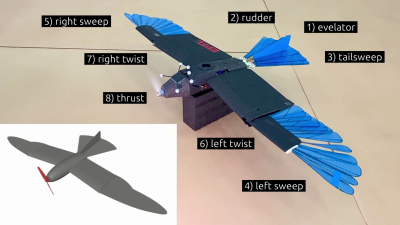Most RC planes follow a simple control scheme: elevators for pitch, rudder for yaw, and ailerons for roll. This one-to-one mapping keeps things straightforward, and fewer actuators means less weight. But nature has other ideas. Birds achieve flight control through complex, coordinated movements where different body parts can affect multiple degrees of freedom simultaneously. Now, researchers at EPFL have brought this biological approach to robotics with the LisEagle, a drone featuring morphing wings and tail that demonstrate remarkable stability.

The LisEagle packs seven different actuation methods alongside its nose-mounted motor. Three of these control the bird-like wingtips and spreading tail, while the remaining actuators handle more conventional controls: independently twisting wing bases (similar to ailerons) and a tail assembly that combines elevator and rudder functions in its vertical stabilizer.
Testing took place in controlled indoor conditions, with the maintaining position in front of an open wind tunnel. Optical position tracking provided closed-loop feedback and power was provided via a tether to minimize weight. A PID flight controller orchestrated all seven actuators in concert, achieving impressive stability even when faced with induced turbulence or being poked with a stick. In a demonstration of redundancy, the researchers deliberately disabled the twisting wing mechanisms, and the aircraft maintained control using just its wingtips and tail.
The team went further, employing Bayesian optimization to find the most efficient actuator combinations. This revealed potential energy savings of up to 11%, with optimal configurations varying based on airspeed as lift requirements changed.
While research into the flight mechanisms of bees, bats and birds might not immediately translate to practical applications, it deepens our understanding of flight control principles. Don’t be surprised if morphing wings become a more common sight in future aircraft designs.
















In future theaters of war, people will slaughter or poison all the local birds just to make sure they don’t provide cover for enemy ornithopter drones carrying HE shaped charges or antipersonnel frag grenades.
Alright that’s my total bummer post for today
Yes, except that birds aren’t real.
Wait…. Birds aren’t real??
What the hell?? When did that happen?
Why am I always the last one to know
History repeating itself… sort of…
https://pigeons-of-war.com/2022/09/13/how-to-sabotage-military-pigeons-a-primer/
I’ve had my bionic bird for a while ,down fall is that hawks and falcons ,think it’s real,and they attack it ,my first was attactd by 2 mocking bird,they really don’t like it, but I love my robot birds. Ty
If you watch (small) birds fly outdoors, you’ll see that many of them exploit their (literal) lifting bodies in a “flap and coast” cycle, folding their wings periodically to “coast”, using their inertia. There are a few hobbyist R/C enthusiasts who have tinkered with folding wing designs and achieve the same thing more or less and can achieve fairly good speeds with modest power outputs.
The Wright brothers’ plane used wing-warping for a similar control scheme.
https://en.wikipedia.org/wiki/Wright_brothers#Ideas_about_control
cut the attached string and watch it fall.
Mostly because the power and control are both wired.
“It’s a bird!”
“It’s a plane!”
“No! It’s small plane that sort of flies like a bird!”
Super! Man!
Get those vstabs outta there! Pitch the wingtips down like a real bird! https://www.youtube.com/watch?v=RoT2upDbdUg